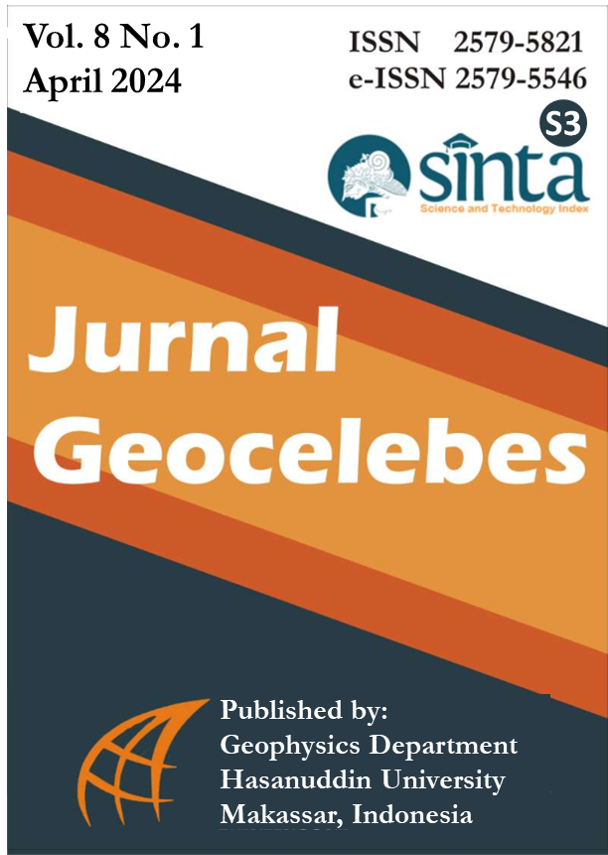Investigation of Sediment Layer Thickness Estimation at Bengkulu University Hospital Based on Microtremor Data
DOI:
https://doi.org/10.20956/geocelebes.v8i1.28144Keywords:
A0, f0, micotremor, sedimentary rocks, T0Abstract
Bengkulu is the capital of Bengkulu Province and is located in the subduction zone between the Eurasian and Indo-Australian plates. Bengkulu is also close to the major faults of Sumatra, namely the Musi fault, the Ketahun fault, and the Manna fault. Therefore, regional planning and infrastructure development for earthquake mitigation is necessary. The purpose of this study is to estimate the thickness of the sedimentary layers in the construction zone of Bengkulu Hospital during the earthquake attenuation phase. This study is conducted by surface geological analysis using the HVSR method; data analysis using microtremor data. The microtremor data were analyzed using the HVSR method to obtain the amplification value (A0) and the dominant frequency (f0). HVSR analysis gave dominant frequency (f0) values from 5.1 to 5.8 Hz, amplification (A0) from 1.64 to 5.91 times, and dominant period (T0) from 1.49 to 2.81 seconds. The values of A0, f0, T0 are interpreted with reference to the literature and surface geology as a moderate risk of seismic vulnerability, characterized by moderate to weak sedimentation and moderate amplification values.
References
Amirudin., Madrinovella, I., & Sopian. (2023). Seismic Vulnerability Analysis Using the Horizontal to Vertical Spectral Ratio (HVSR) Method on the West Palu Bay Coastline. Journal of Geoscience, Engineering, Environment, and Technology, 08(02), 23–34.
Asnawi, Y., Simanjuntak, A. V. H., Umar, M., Rizal, S., & Syukri, M. (2020). A Microtremor Survey to Identify Seismic Vulnerability Around Banda Aceh Using HVSR Analysis. Elkawnie: Journal of Islamic Science and Technology, 6(2), 342–358. https://doi.org/10.22373/ekw.v6i2.7886
Dal Moro, G., & Panza, G. F. (2022). Multiple-peak HVSR curves: Management and statistical assessment. Engineering Geology, 297, 106500. https://doi.org/10.1016/j.enggeo.2021.106500
Ghuge, D. L. (2023). Application of the HVSR Technique to Map the Depth and Elevation of the Bedrock Underlying Wright State University Campus, Dayton, Ohio. Wright State University. http://rave.ohiolink.edu/etdc/view?acc_num=wright1683237719091288
Farid, M., & Mase, L. Z. (2020). Implementation of seismic hazard mitigation on the basis of ground shear strain indicator for spatial plan of Bengkulu city, Indonesia. International Journal of GEOMATE, 18(69), 199–207. https://doi.org/10.21660/2020.69.24759
Haryanto, Y., Hu, H.-T., Han, A. L., Hidayat, B. A., Widyaningrum, A., & Yulianita, P. E. (2020). Seismic Vulnerability Assessment Using Rapid Visual Screening: Case Study of Educational Facility Buildings of Jenderal Soedirman University, Indonesia. Civil Engineering Dimension, 22(1), 13–21. https://doi.org/10.9744/ced.22.1.13-21
Hesti., Suharno., Mulyasari, R. & Hidayatika, A. (2021). Analisis Karakteristik Lapisan Sedimen Berdasarkan Data Mikrotremor di Area Rumah Sakit Pendidikan UNILA. Jurnal Geofisika Eksplorasi, 7(2), 150–159. https://doi.org/10.23960/jge.v7i2.123
Imposa, S., Lombardo, G., Panzera, F., & Grassi, S. (2018). Ambient vibrations measurements and 1D site response modelling as a tool for soil and building properties investigation. Geosciences (Switzerland), 8(3), 1–21. https://doi.org/10.3390/geosciences8030087
Irsyam, M., Widiyantoro, S., Natawidjaja, D. H., Meilano, I., Rudyano, A., Hidayati, S., Triyoso, W., Hanifa, N. R., Djarwadi, D., Faizal, L., & Sunarjito. (2017). Peta Sumber dan Bahaya Gempa Indonesia tahun 2017. Kementrian Pekerjaan Umum dan Perumahan Rakyat.
Isburhan, R. W. P., Nuraeni, G., Ry, R. V., Yudistira, T., Cipta, A., & Cummins, P. (2019). Horizontal-to-Vertical Spectral Ratio (HVSR) Method for Earthquake Risk Determination of Jakarta City with Microtremor Data. IOP Conference Series: Earth and Environmental Science, 318(1), 012033. https://doi.org/10.1088/1755-1315/318/1/012033
Lestari, D. A., & Susiloningtyas, D. (2022). Spatial Analysis of Social Vulnerability to Earthquake Hazard in Bengkulu City. International Journal on Advanced Science, Engineering and Information Technology, 12(5), 1989–1996. https://doi.org/10.18517/ijaseit.12.5.11889
Mase, L. Z. (2017). Liquefaction potential analysis along coastal area of Bengkulu province due to the 2007 Mw 8.6 Bengkulu earthquake. Journal of Engineering and Technological Sciences, 49(6), 721–736. https://doi.org/10.5614/j.eng.technol.sci.2017.49.6.2
Mase, L. Z., Amri, K., Farid, M., Rahmat, F., Fikri, M. N., Saputra, J., & Likitlersuang, S. (2022). Effect of Water Level Fluctuation on Riverbank Stability at the Estuary Area of Muaro Kualo Segment, Muara Bangkahulu River in Bengkulu, Indonesia. Engineering Journal, 26(3), 1–16. https://doi.org/10.4186/ej.2022.26.3.1
Mase, L. Z., Sugianto, N., & Refrizon. (2021). Seismic hazard microzonation of Bengkulu City, Indonesia. Geoenvironmental Disasters, 8(5), 1–17. https://doi.org/10.1186/s40677-021-00178-y
Meng, Q., Li, Y., Wang, W., Chen, Y., & Wang, S. (2023). A Case Study Assessing the Liquefaction Hazards of Silt Sediments Based on the Horizontal-to-Vertical Spectral Ratio Method. Journal of Marine Science and Engineering, 11(1), 104. https://doi.org/10.3390/jmse11010104
Mohamed, A., El khateeb, S. O., Dosoky, W., & Abbas, M. A. (2021). Site Effect Estimation Using Microtremor Measurements at New Luxor City Proposed Site, South Egypt*. Journal of Geoscience and Environment Protection, 09(09), 131–149. https://doi.org/10.4236/gep.2021.99008
Moustafa, S. S. R., Abdalzaher, M. S., Naeem, M., & Fouda, M. M. (2022). Seismic Hazard and Site Suitability Evaluation Based on Multicriteria Decision Analysis. IEEE Access, 10(July), 69511–69530. https://doi.org/10.1109/ACCESS.2022.3186937
PASI. (2013). HVSR data acquisition unit GEMINI-2 user manual. Torino, Italy: PASI.
Ridwan, M., Yatini, Y., & Pramono, S. (2021). Mapping of Potential Damages Area in Lombok Island Base on Microtremor Data. Jurnal Pendidikan Fisika Indonesia, 17(1), 49–59. https://doi.org/10.15294/jpfi.v17i1.27028
Ryanto, T. A., Iswanto, E. R., Indrawati, Y., Setiaji, A. B., & Suntoko, H. (2020). Sediment Thickness Estimation in Serpong Experimental Power Reactor Site Using HVSR Method. Jurnal Pengembangan Energi Nuklir, 22(1), 29–37. https://doi.org/10.17146/jpen.2020.22.1.5949
Saputra, F. R. T., Rosid, M. S., Fachruddin, I., Ali, S., Huda, S., & Wiguna, I. P. A. P. (2022). Analysis of Soil Dynamics and Seismic Vulnerability in Kalibening District, Banjarnegara Using the HVSR Method. Journal of Physics: Conference Series, 2377(1), 012038. https://doi.org/10.1088/1742-6596/2377/1/012038
Silitonga, B. E., Suardi, I., Firmansyah, A., Hanif, M., Ramdhan, M., & Sembiring, A. S. (2023). Tectonic Structures of Northern Sumatra Region Based on Seismic Tomography of P and S Wave Velocity. Eksplorium, 44(1), 1–12.
Downloads
Published
How to Cite
Issue
Section
License
Authors who publish with this journal agree to the following terms:
- Authors retain copyright and grant the journal right of first publication with the work simultaneously licensed under a Creative Commons Attribution License that allows others to share the work with an acknowledgement of the work's authorship and initial publication in this journal.
- Authors are able to enter into separate, additional contractual arrangements for the non-exclusive distribution of the journal's published version of the work (e.g., post it to an institutional repository or publish it in a book), with an acknowledgement of its initial publication in this journal.
- Authors are permitted and encouraged to post their work online (e.g., in institutional repositories or on their website) prior to and during the submission process, as it can lead to productive exchanges, as well as earlier and greater citation of published work (See The Effect of Open Access).





